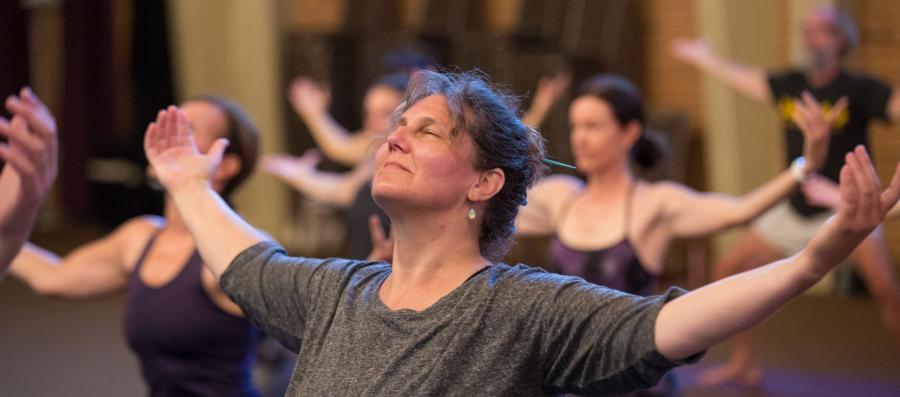Turning Stress into Strength

We often hear about the negative impact of stress—how it can raise blood pressure, interfere with sleep, increase anxiety levels, and even damage the brain. It’s true: Stress can have a negative impact on our health. We all need to find ways to decompress, release tension, and activate our relaxation response.
But is all stress bad? Are we right to worry each time we get stressed? What if we’ve overemphasized the negative impact of stress and forgotten that age-old yogic adage: Everything in balance?
Recent research suggests that, actually, not all stress is bad. In fact, the right amount of stress may be just what you need to increase your productivity, facilitate better interpersonal relationships, promote emotional growth, and even increase quality of life.
One study conducted by Yale and Harvard researchers Alia Crum and Shawn Achor investigated some of these benefits of stress. They divided participants into two groups. One group watched a three-minute video about the detrimental effects of stress, while the other group watched a video about the positive impact of stress. The researchers found that the group that was shown the video on the positive effects of stress reported fewer physical ailments—such as headaches and back pain—and improvements in life satisfaction. The other group did not report these benefits.
Another study investigating self-reports of stress levels and the perceptions of stress found that it was neither the amount of stress participants reported nor their perceptions of stress that put them at the highest risk for poor mental and physical health outcomes. It was the combination—both having stress and believing that it was bad for you. Individually, neither is all that risky. But when you get stressed about being stressed, you add extra worry and therefore tax your body more. For some, worrying about stress replaces taking skillful action to reduce stress, and therefore exacerbates the problem.
Whatever the reason, it seems that while there is a negative impact in combing these two—actual stress and perceptions about stress—it also provides two ways to untangle from this knot: keep working on de-stressing and, when stress does arise, hold it in your mind differently.
Reframing Stress
There’s a difference between chronic stress states (which occur when we don’t give ourselves enough downtime or self-care) and moments or times of stress. Moments of stress happen all the time and can help us grow and get stronger. For example, we sometimes mislabel excitement as anxiety. The physiological markers are often the same—faster heart rate and breath rate, increased energy, and a racing mind. Often people who tend to be anxious will experience all physiological experiences like this as anxiety, when, in fact, some of it is excitement or anticipation. And thinking you’re excited versus thinking you’re anxious makes a difference. This is not to discount true moments of anxiety, but reframing the experience from anxiety to excitement can help us navigate experience more easily.
The same idea could be applied to stress in certain times, such as leading up to a big deadline or going through a divorce. Instead of getting worried about being stressed (which can add to your stress), you could understand it as stress in the service of greater growth and development. Nearly all growth processes and advancements include a time of perceived stress, but we don’t have to fall prey to the negative side effects of stress.
Build a Stress-Management Toolkit
Using stress as strength is a practice; each of us has a smaller or wider bandwidth to tolerate higher or lower levels of stress. And no one can tolerate high amounts of stress skillfully without some tools.
To increase the likelihood of your stress offering you greater strength, pull out your favorite mind-body tools for even the smaller stuff. Stuck in traffic? Practice yogic breathing or try a body scan. Find yourself in a scuffle at work? Try reframing the experience as a cue that something may need more attention—whether it be a catalyst to improve office communication or a reminder that you need to take five minutes for yourself each day. And don’t underestimate the benefits of simply tolerating a little discomfort (no tool other than acceptance needed), knowing that it too will pass.
The upside of stress is that we are challenging ourselves to get out of our comfort zone, and expanding what we thought was possible. Even in yoga, there might be moments of stress, such as when practicing a new pose, but that stress helps expand our awareness about who we have known ourselves to be.
Next time you feel stressed, check in with yourself. Is this the kind of stress that needs to be curbed, or welcomed? Then adjust from there. Like so many things in life and in yoga, it is all an experiment. Let the idea of healthy stress be part of your understanding of yourself and of the variety of experiences that come your way.
Find out about programs with Angela Wilson at Kripalu.
© Kripalu Center for Yoga & Health. All rights reserved. To request permission to reprint, please email editor@kripalu.org.
































